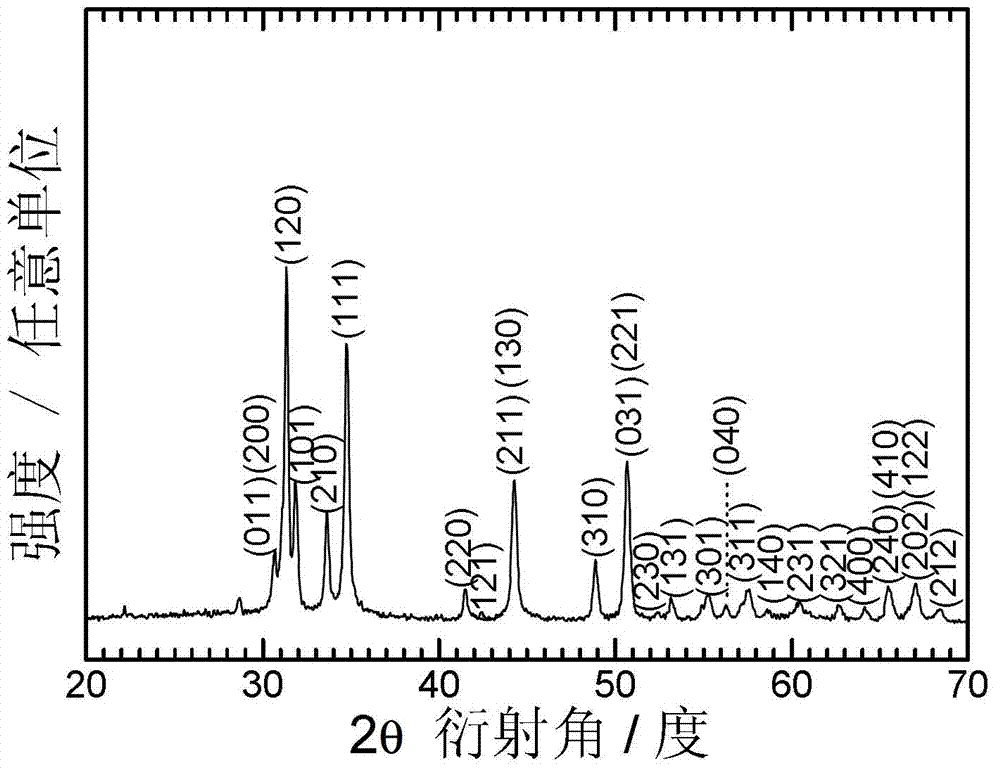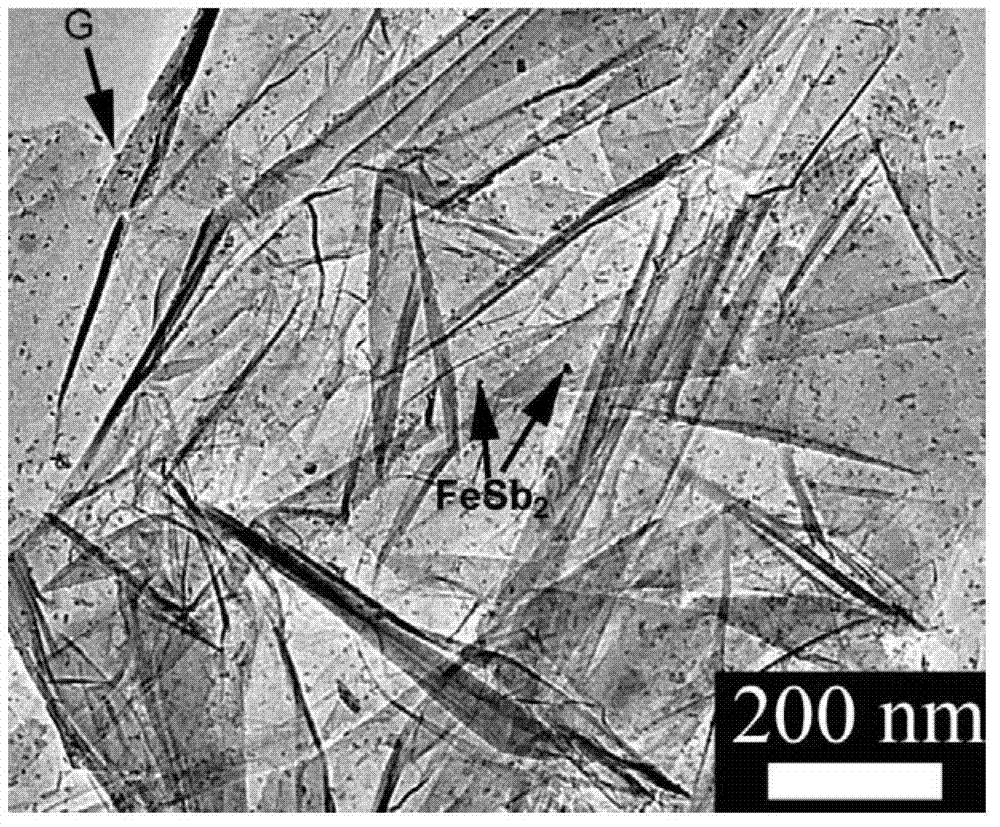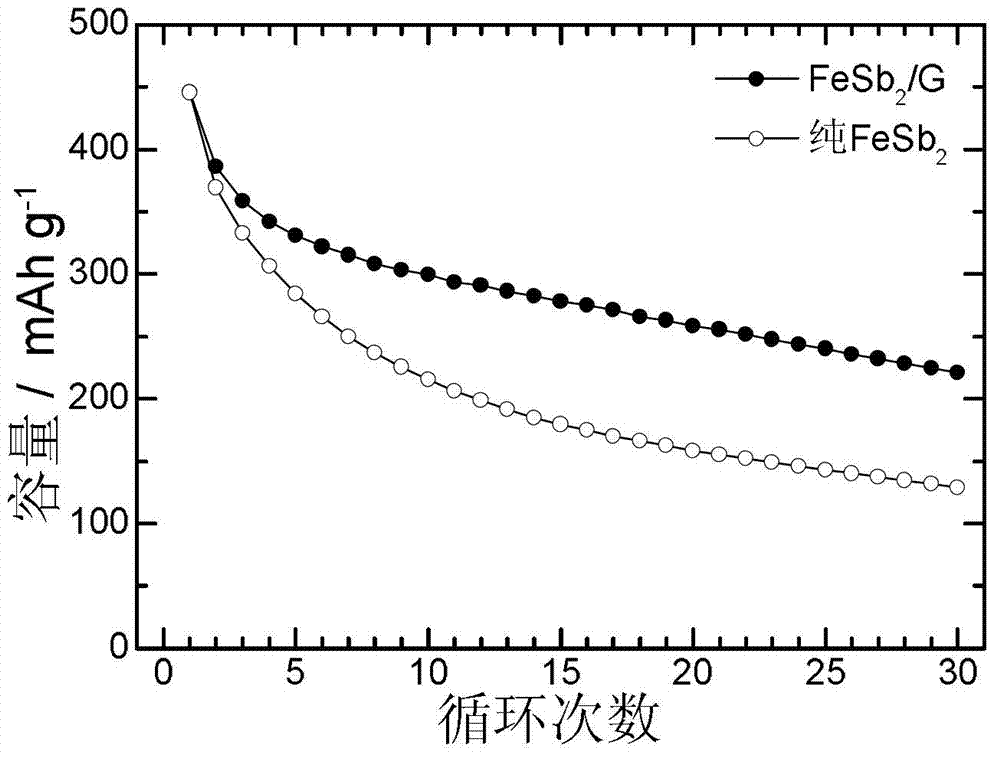Transitional metal 2-antimonide/grapheme composite material and preparation method and application thereof
A technology of transition metals and composite materials, which is applied in the direction of electrical components, battery electrodes, circuits, etc., can solve the problems of poor electrochemical stability of antimony-based alloy materials, large volume changes of antimony-based alloys, and increased preparation costs, etc., to achieve improved electrochemical performance. Stability, low cost, evenly distributed effect
- Summary
- Abstract
- Description
- Claims
- Application Information
AI Technical Summary
Problems solved by technology
Method used
Image
Examples
Embodiment 1
[0033] 1) The analytically pure SbCl 3 and FeSO 4 ·7H 2O, according to the proportion of Fe:Sb atomic ratio 1:2, mixed in diethylene glycol to obtain FeSb 2 The meter concentration is the mixed solution of 0.2mol / L, and the mixed solution volume is 80 milliliters.
[0034] 2) After adding 1.4 grams of GO to the mixed solution in step 1), place it in a high-pressure reactor with a capacity of 100 ml (filling degree 80%, volume percentage), and add 19.2 grams of reducing agent NaBH to the solution 4 , then seal immediately.
[0035] 3) Heating the reactor to 180°C and reacting for 28 hours.
[0036] 4) Naturally cool to room temperature after the reaction, collect the powdery reaction product at the bottom of the kettle, wash it with deionized water and absolute ethanol alternately and repeatedly for several times, then vacuum dry the powder at 110°C for 12 hours to obtain a composite material powder , the weight percentage of graphene in the composite material is 12%.
[...
Embodiment 2
[0040] 1) Analytical pure Sb(NO 3 ) 3 and CoCl 2 ·6H 2 O, NiSO 4 ·7H 2 O, according to the ratio of Co: Ni: Sb atomic ratio 0.9: 0.1: 2, mixed in deionized water to obtain Co 0.9 Ni 0.1 Sb 2 The meter concentration is the mixed solution of 0.05mol / L, and the mixed solution volume is 80 milliliters.
[0041] 2) After adding 120 mg of GO to the mixed solution in step 1), place it in a high-pressure reactor with a capacity of 100 ml (filling degree 80%, volume percentage), and add 4.1 g of reducing agent KBH to the solution 4 , then seal immediately.
[0042] 3) Heating the reactor to 160°C and reacting for 40 hours.
[0043] 4) Naturally cool to room temperature after the reaction, collect the powdery reaction product at the bottom of the kettle, wash it with deionized water and absolute ethanol alternately and repeatedly for several times, then vacuum dry the powder at 110°C for 12 hours to obtain a composite material powder , the weight percent of graphene in the com...
Embodiment 3
[0047] 1) The analytically pure SbCl 3 , NiSO 4 ·7H 2 O and FeSO 4 ·7H 2 O is mixed in anhydrous glycerol after being dosed according to the ratio of Ni:Fe:Sb atomic ratio 0.5:0.5:2 to obtain Ni 0.5 Fe 0.5 Sb 2 The meter concentration is the mixed solution of 0.15mol / L, and the mixed solution volume is 80 milliliters.
[0048] 2) After adding 180 mg of GO to the mixed solution in step 1), place it in a high-pressure reactor with a capacity of 100 ml (filling degree 80%, volume percentage), and add 7.8 grams of reducing agent NaBH to the solution 4 , then seal immediately.
[0049] 3) Heating the reactor to 200°C and reacting for 36 hours.
[0050] 4) Naturally cool to room temperature after the reaction, collect the powdery reaction product at the bottom of the kettle, wash it with deionized water and absolute ethanol alternately and repeatedly for several times, then vacuum dry the powder at 110°C for 12 hours to obtain a composite material powder , the weight percen...
PUM
| Property | Measurement | Unit |
|---|---|---|
| diameter | aaaaa | aaaaa |
| thickness | aaaaa | aaaaa |
| particle diameter | aaaaa | aaaaa |
Abstract
Description
Claims
Application Information
 Login to View More
Login to View More - R&D
- Intellectual Property
- Life Sciences
- Materials
- Tech Scout
- Unparalleled Data Quality
- Higher Quality Content
- 60% Fewer Hallucinations
Browse by: Latest US Patents, China's latest patents, Technical Efficacy Thesaurus, Application Domain, Technology Topic, Popular Technical Reports.
© 2025 PatSnap. All rights reserved.Legal|Privacy policy|Modern Slavery Act Transparency Statement|Sitemap|About US| Contact US: help@patsnap.com



